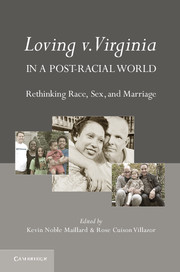Book contents
- Frontmatter
- Contents
- About the Contributors
- Acknowledgments
- Foreword
- Introduction Loving v. Virginia in a Post-Racial World
- Part One Explaining Loving v. Virginia
- Part Two Historical Antecedents to Loving
- Part Three Loving and Interracial Relationships: Contemporary Challenges
- Part Four Considering the Limits of Loving
- Part Five Loving Outside the U.S. Borders
- Part Six Loving and Beyond: Marriage, Intimacy, and Diverse Relationships
- 17 Black v. Gay?
- 18 Beyond the Loving Analogy
- 19 The End of Marriage
- Afterword
- Permission Granted
- Index
- References
18 - Beyond the Loving Analogy
The Independent Logic of Same-Sex Marriage
Published online by Cambridge University Press: 05 July 2012
- Frontmatter
- Contents
- About the Contributors
- Acknowledgments
- Foreword
- Introduction Loving v. Virginia in a Post-Racial World
- Part One Explaining Loving v. Virginia
- Part Two Historical Antecedents to Loving
- Part Three Loving and Interracial Relationships: Contemporary Challenges
- Part Four Considering the Limits of Loving
- Part Five Loving Outside the U.S. Borders
- Part Six Loving and Beyond: Marriage, Intimacy, and Diverse Relationships
- 17 Black v. Gay?
- 18 Beyond the Loving Analogy
- 19 The End of Marriage
- Afterword
- Permission Granted
- Index
- References
Summary
In recent years, there has been a renaissance of interest in Loving v. Virginia because of its role in the same-sex marriage debate. According to some gay and lesbian advocates, the Court’s decision to strike down bans on interracial marriage provides a constitutional roadmap for undoing sex-based restrictions on the right to marry. Although the analogy to Loving has produced high-profile courtroom victories, these novel arguments also have yielded a number of defeats. Interestingly, recent litigation successes in the same-sex marriage campaign have turned on a new constitutional logic, one that does not depend on extensive comparisons to race. As important as this emerging logic is in addressing the historical exclusion of same-sex couples from marriage, the approach is but a first step in understanding fully what authentic liberty and equality mean in the realm of intimacy.
The Loving Analogy in Same-Sex Marriage Cases
The Loving analogy has served several key purposes in the same-sex marriage movement. For one thing, the landmark 1967 civil rights decision demonstrates that courts can nullify even long-standing marriage laws, so long as they are rooted in irrational discrimination, whether that be racism or homophobia. In addition to this principle of equal treatment, the opinion makes clear that the freedom to marry is a fundamental right, one that cannot be burdened without a compelling justification. So, stereotypical images of interracial marriages as unstable and antisocial could not justify antimiscegenation laws, nor should misleading portraits of gay and lesbian relationships be used to uphold bans on same-sex marriage. Overall, then, Loving shows that tradition alone, whether of same-race or opposite-sex marriages, cannot be invoked to perpetuate exclusion and subordination.
- Type
- Chapter
- Information
- Loving v. Virginia in a Post-Racial WorldRethinking Race, Sex, and Marriage, pp. 242 - 252Publisher: Cambridge University PressPrint publication year: 2012

